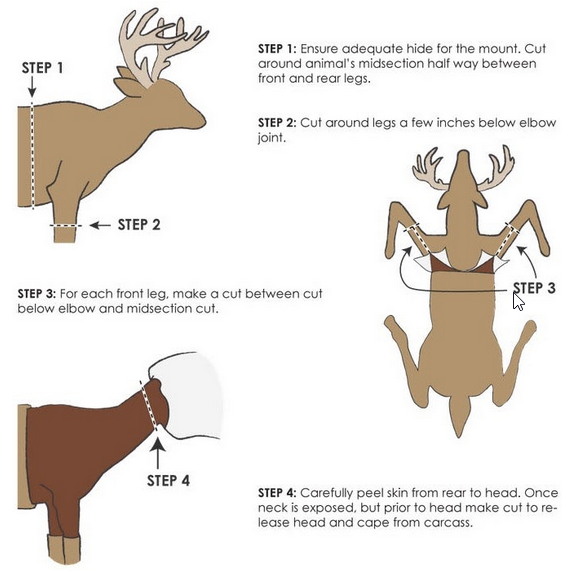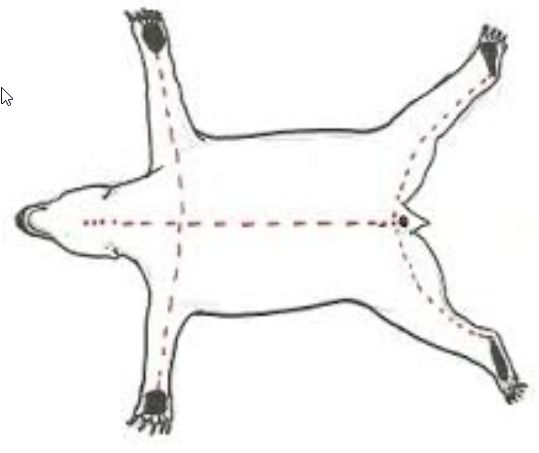Field Care
Proper Field care is essential to a quality mount
Essential field care is a must if you plan to mount your trophy, regardless of specimen type. Proper skinning and handling of your trophy is paramount to ensure a quality mount.
Game Heads
Capes should be cut according to the pictures below. Cut the cape longer if in doubt. Bring it in within a day or two depending on temperatures, or freeze it. When gutting an animal for a head mount, stop at the rib cage for the best mount quality. It is best to wipe wet blood off the hide.

Lifesize / Full Mounts
If possible, call before skinning or gutting a life-size mount for the best skinning options. If you will be doing a lifesize mount, it is important to retain the genitalia. If you will be doing a rug, it is important that you keep your incision in the center of the belly. If it is not in the center, it will throw off the symmetry of the rug. Start your incision at the sternum and continue down to the anus. Continue field dressing in the normal fashion. If you will be dragging your trophy out, take care not to damage the hair in doing so. Life-size hides and rugs should be skinned like the bear picture, with straight cuts. Don’t cut hair or parts of the hide-off. Wipe as much blood off the hide as possible.

Small Game
Bring small game in ASAP for proper skinning. If not able to bring it right away, freezing it whole is best the best option. Either way, wipe wet blood off of the hide if possible. To freeze it, stretch it out with the front legs extended forward and back legs extended backward to cool it and freeze faster. Freezing in this position allows for easier skinning while still semi-frozen, helping to prevent spoilage which can happen quickly with small animals.
Skull mounts
Skull mounts should be brought in fresh or frozen. Remove hide and as much of the eyes, brain, and meat as possible.
Fish
For skin mounted fish, lay fish flat with fins against the body. You may opt to wrap the fish in several layers of newspapers and place into a couple layers of plastic bags. Remember to never gut a fish if you plan to mount!
If you plan to do a replica mount, be sure to measure the length and girth (widest part of the body). It is recommended to take pictures as soon as possible to capture the color detail.
Common mistakes and tips
Improper Alignment- Most taxidermists are hunters themselves and understand the problems with skinning in the field, however not proper aligning or moving the animal to ensure cuts are made in the proper spots is a very common mistake. Take the time to move debris or the animal around so you can make clean, smooth cuts in the correct locations and avoid wavy incisions.
Trimming- Do not trim off any hide thinking it is damaged or soiled, leave everything that is attached to the hide. While trimming excess fat and meat from the hide is good practice, especially for an extended pack out of the woods, be careful that you don’t trim too much and inadvertently cut the hide.
Keep it clean- Bear fur, unlike ‘haired’ animals, collect and hold debris incredibly well. Sometimes it’s next to impossible due to the ground where the bear fell, but consider packing a tarp to put the animal onto before skinning. Between the blood, weather, and terrain it could cause your taxidermist to silently curse you if the hide is packed full of small fir needles or burs. Present your taxidermist with relatively clean hide/fur and you will be greatly appreciated.
"You’ve taken the time to get your trophy AND to get it safely out of the hunting area. Now make sure you don’t make a hasty decision as to what taxidermist does the work. Top-quality taxidermy is the name of the game. Remember “The bitterness of poor quality remains long after the sweetness of low price is forgotten!”
